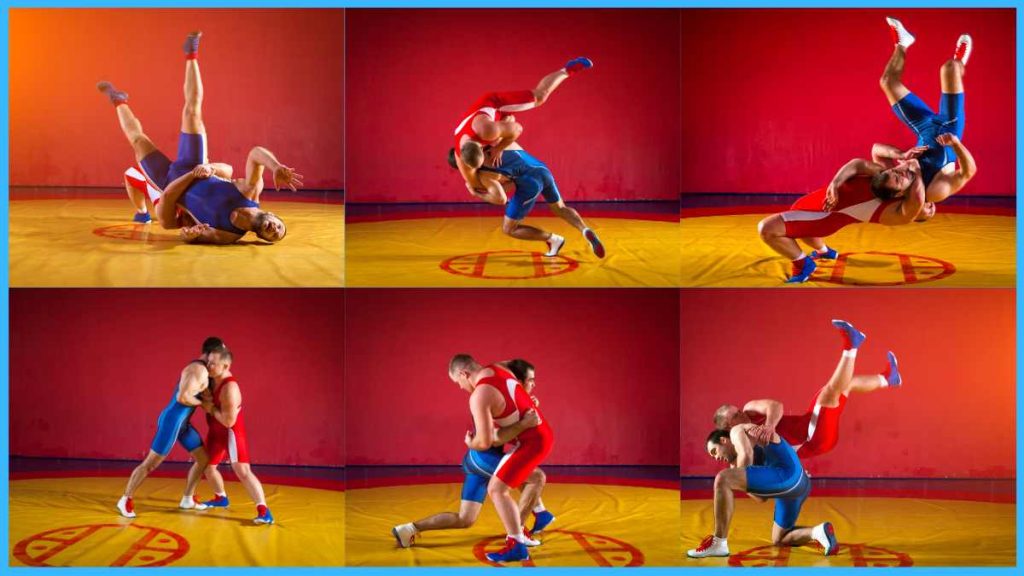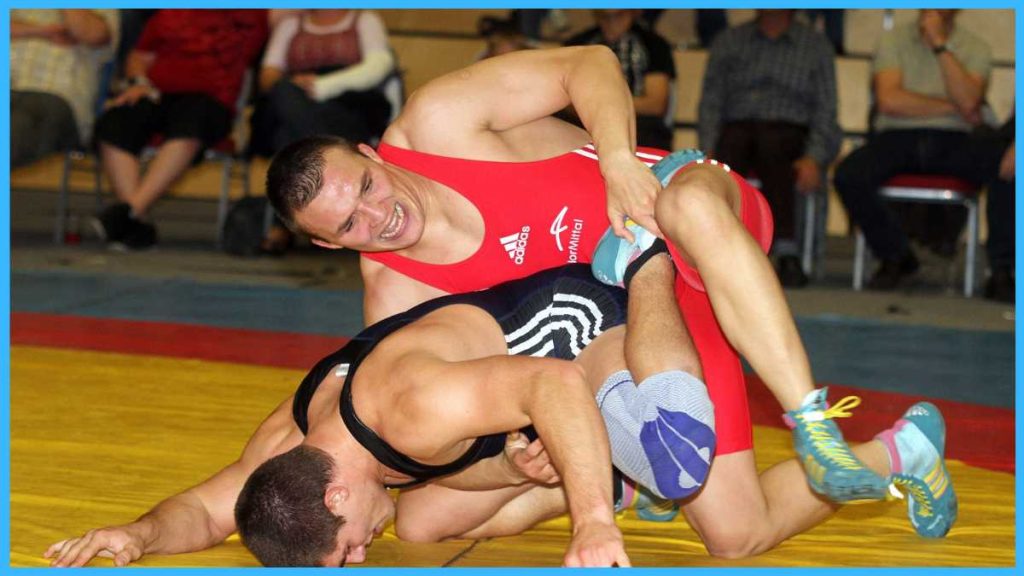Do you think you have what it takes to make a name in the world of Greco-Roman wrestling? Are you well-versed with the rules of this highly celebrated wrestling style? What about the Greco-Roman Wrestling rules? Well, you are in luck because today, we will be discussing Greco-Roman Wrestling and its rules (besides other things) in detail.
From a zoomed-out perspective, Greco-Roman Wrestling is similar to other wrestling formats, barring one small but significant exception—no holds or maneuvers below the waist. This makes a Greco-Roman wrestling contest really exciting because the wrestlers can only use their upper body to attack or defend. Interesting, right? Well, Greco-Roman wrestling rules make this way too easy for the wrestlers to combat with their opponents. Curious to know how? Then, keep reading!
Table of Contents
How To Greco-Roman Wrestle?
Two wrestlers meet at the center of a circular ring, demarcated with different colors. One wrestler wears red, while the other wears blue. Once the referee signals for the contest to begin, both wrestlers, while abiding by the greco-roman wrestling rules, try to pin their opponents or outscore them using a mix of strategy, technical skills, strength, and more.
Objective
The objective of Greco-Roman wrestling is to pin your opponent or dominate them by scoring more points. The ultimate goal is to win, and there are more ways than one to achieve it. We will discuss this later in this article. So, keep reading.

Greco Roman Wrestling Rules
Before we get into the specifics of this particular sport and discuss some important associated terms, let us first get used to the rules. Here are some essential Greco-Roman wrestling rules that you must be aware of:
- All attacks, grips, and grapples must be limited to the opponent’s torso (waist and above). This means wrestlers cannot grapple or grab their opponent’s knees, legs, feet, etc.
- Knee strikes, kicks, and leg trips are absolutely forbidden.
- Greco-Roman wrestling rules suggest that wrestlers cannot exit or step out of the mat in the middle of the competition unless allowed to. This will result in ‘Out of Bounds,’ and the opponent will be awarded a point.
- Wrestlers are expected to carry themselves like athletes. Berating or abusing opponents is frowned upon and can result in a penalty or, worse, a DQ (disqualification).
- The first 60 seconds of the match are called neutral contests. In this segment, wrestlers must try to score higher than their opponents.
- After the neutral segment, the ground combat segment begins (1-minute or 30-second rounds). The wrestler who won the neutral segment is given the top position. This is an advantageous position, and the wrestler at the lower position has to try to reverse the game or defend himself. Then, the positions are changed, and the wrestler in the lower position in the earlier ground segment gets his turn at the top. This is called the ‘Period Format.’
- According to the Greco wrestling rules, if the wrestler at the top cannot score a point, the wrestler in the lower position is awarded 1 point for good defense.
- If neither wrestler can secure points, the referee decides who gets the top position first, using a coin toss or a colored disc.
Now that you know about the game’s basic rules and how one is expected to conduct themselves on the wrestling mat, it is time to learn about the different aspects of the game in detail.
Points System
In this section of the article, we will discuss how the point system works in Greco-Roman wrestling. They are as follows:
- Takedown – If you manage to pin your opponent down to the mat and secure control over them, this is called a takedown. A takedown is worth anything between 2 to 5 points. Your score points for each takedown depend on the grandeur and amplitude. For example, if you execute a difficult technique or takedown maneuver, you will score 5 points. The simple takedowns will earn you 2 points. The complexity and the magnitude of the takedowns decide how many points a wrestler can earn from it.
- Escape—If a wrestler can free themselves from a disadvantageous position or get into a defensive or neutral position by escaping from the attacker, this is called an Escape. It is worth 1 point.
- Reversal—If a wrestler can turn the tide of the contest, using technique and strength, and turn a defensive position into an offensive one, it is called a reversal and is worth 1 point.
- Exposure – When in an offensive position, if a wrestler can expose their opponent’s back to the floor or the mat while assuming complete control (top or side), this is called exposure. An exposure can be worth 2 or 3 points. This depends on the length of time for which you almost pin your opponent.
Penalty
According to the Greco-Roman wrestling rules, a player is penalized if their opponent commits a foul or resorts to an illegal move. In this case, the offending player’s opponent is awarded penalty points. Being a physical sport, penalties are common in Greco-Roman wrestling, and there are numerous ways in which this can happen.
Periods
Periods are halves of the entire wrestling match/contest. According to the Greco Roman wrestling rules, every contest consists of two periods of 3 minutes each. A wrestler must win in both periods (by pinfall, points, or other means) to secure a victory. However, a third period is introduced if the scores are tied and neither wrestler can be declared a clear winner. This means that if a wrestler is behind on points, they can still win the contest by pinning or turning the tide of the game by the third period.

Greco-Roman Wrestling Techniques And Moves
There are three techniques and moves that most wrestlers resort to in a Greco-Roman wrestling contest. The umbrella remains the same, while modifications and additions are made to nearly all of these moves. Here are the 3 most important moves and techniques according to the Greco-Roman Wrestling rules:
- Suplex – This is by far one of the most complicated moves to execute. However, suplexes can earn you many points or win you the fight if done correctly. Wrestlers use many variations, such as the belly-to-belly suplex, back-to-belly suplex, and back-arch suplex. In these combinations, the wrestler lifts their opponent over their head and brings them down on the mat to pin them or gain top control.
- Arm Throw—The arm throw is a very common tool in the arsenal of every Greco-Roman wrestler. This move is highly effective and easy to execute. It is also commonly referred to as a ‘hip throw.’ In this technique, the wrestler grabs the arm or arms of their opponent and, using a combination of force and movement generated from the hips and their upper body, throws the opponent down to the mat, like a throw.
- Gut Wrench – In this technique, a wrestler assumes total control of their opponent’s midsection, often from a clinch position. Then, the wrestler in control squeezes the opponent’s midsection and twists and turns them to throw them off balance and turn them to get a pin.
A wrestler can combine one or more of these moves and techniques to score a pin or points while following Greco-Roman wrestling rules.
Important Terms
Now that you are familiar with the bare bones of Greco wrestling rules, it is time to talk about some essential terms of the sport. Here are a few:
Caution
If a wrestler resorts to violating one or more Greco wrestling rules, uses illegal moves or shows no intention of wrestling, then the referee can issue a caution to this wrestler. This is a warning of sorts. The referee can also award penalty points to the opposition.
Out Of Bounds
If a wrestler puts even one foot outside the wrestling circle, they are ‘Out of Bounds.’ The wrestler is then cautioned, and 1 point is given to the opponent.
Passivity
If a wrestler tries to buy time by avoiding contests or continues to run away to avoid conflict, this is called ‘passivity,’ and the wrestler is cautioned. The Greco-Roman wrestling rules also state that the opponent is given 1 point.
Par Terre (Clinch)
The Par Terre is a clinch awarded to an offended wrestler. If a wrestler is cautioned, instead of a penalty, the referee can choose to declare a Par Terre. In this situation, the offending wrestler assumes the lower (disadvantageous) position on his knees and hands. The offended player is then allowed a free pass to grapple from the top and try to score a point.

Scoring
Different maneuvers earn you different points in Greco-Roman wrestling. Also there are different points for defensive manoeuvres as well. Here are the ways to score:
- Takedown – 2 to 5 points
- Reversals – 1 point
- Escapes – 1 point
- Exposure – 2 or 3 points
- Penalties – 1 or 2 points
- Out of Bounds – 1 point
Winning
The Greco Roman wrestling rules state that there are many ways to win in Wrestling. You can either win by pinning your opponent, or you can outscore your opponents. This is called a win by technical superiority. Also, a wrestler can win if their opponent doesn’t continue the contest or is disqualified. Let’s dive into the details:
Pin/Win By Fall
When a wrestler is able to take down their opponent to the ground so that the opponent’s back is on the mat and both their shoulder blades touch the mat for 1-2 seconds, it is called ‘a pin’ or a ‘win by fall.’
Technical Superiority
If one wrestler can accrue an 8-point lead over their opponent, then that wrestler is automatically declared the winner by Technical Superiority. It is a sign of complete domination.
Injury, Forfeit, Or Disqualification
If a wrestler cannot continue the contest owing to an injury suffered during the contest, the opponent is declared the winner by injury. If a wrestler cannot start or resume the contest, the opponent will be declared a winner by forfeit. Greco wrestling rules also state that if a wrestler is cautioned 3 times or is banned by the referee from competing further in that contest, then the opponent is declared a winner by disqualification.

Equipment & Court
Wrestling Mat
The wrestling mat is circular and made of rubber. It is 9 m in diameter. The different areas of the mat are demarcated. For example, the ‘Out of Bounds’ area and the ‘Passivity’ area are marked by different colored circles.
Equipment
Now that, we know about greco-roman wrestling rules, let’s learn about the equipment used in this contest. Here is a list of the equipment used in Greco-Roman Wrestling:
- Helmet—These are optional. However, some players need to wear them due to physical conditions, while others prefer to use them for safety.
- Wrestling Shoes—Wrestlers need to wear special shoes that provide grip, balance, and flexibility because they need to jostle and engage physically.
- Singlet – Singlets are uniforms that wrestlers need to wear to compete. They are usually made from materials like Lycra. They allow free movement, thereby leaving room for flexibility.
- Blood Rag—It is not uncommon for fighters to bleed during a contest. Greco-Roman Wrestling is extremely physical, and since bleeding is common, wrestlers are allowed to carry a blood rag inside their singlet to wipe and stop blood flow.

Did You Know?
- Although this wrestling format was named to honor Greek and Roman wrestling, the style was invented in France in the 19th century.
- Greco-Roman Wrestling was one of the first original sports to be included in the modern Olympics back in 1896.
- Greco-Roman Wrestling is currently an all-men’s sport. The weight classes are between 55 kg and 130 kg.
- Many military training includes Greco-Roman wrestling as part of their hand-to-hand combat training.
FAQs
What are the different types of Wrestling?
The different types of Wrestling include Freestyle, Greco-Roman, Sambo, Folkstyle (collegiate), Catch Wrestling, Kushti, Pankration, Shuai Jao, and Mongolian Wrestling.
How many points do you need to win in a wrestling match?
It depends. Different competitions or wrestling styles have different point caps for winning. For example, according to the Greco wrestling rules, the first wrestler to reach 8 points wins.
How long does an Olympic wrestling match last?
A Greco-Roman wrestling competition lasts for two periods of 3 minutes each with provision for additional rounds in case a winner is not declared. However, there is no saying how long the complete match can last.
What is “caution” in Wrestling?
‘Caution’ is a warning that the referee issues to a wrestler if they delay fights, resort to illegal moves, break the Greco-Roman wrestling rules, avoid contests, etc.
Greco-Roman wrestling aims to put on a show and display your skills, technique, and strength as a wrestler. Although relatively new, this style of Wrestling has quickly become famous worldwide because it is exhilarating to watch. The way wrestlers use tactical brilliance and combine that with their skills while following the Greco-Roman wrestling rules is genuinely fantastic to see. If you want to know more about such games, then keep coming back to Play With Rules.
So, now that we have learned about Greco-Roman Wrestling let’s take a look at the Golf Card Game.

